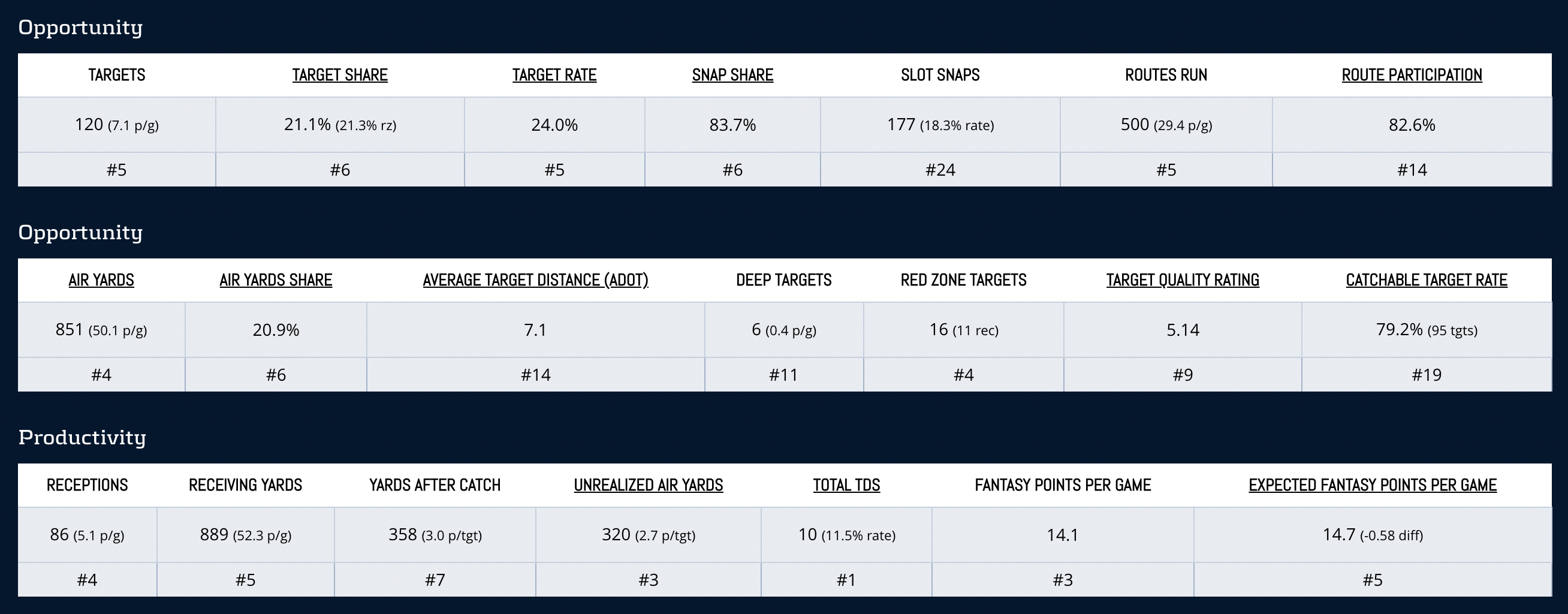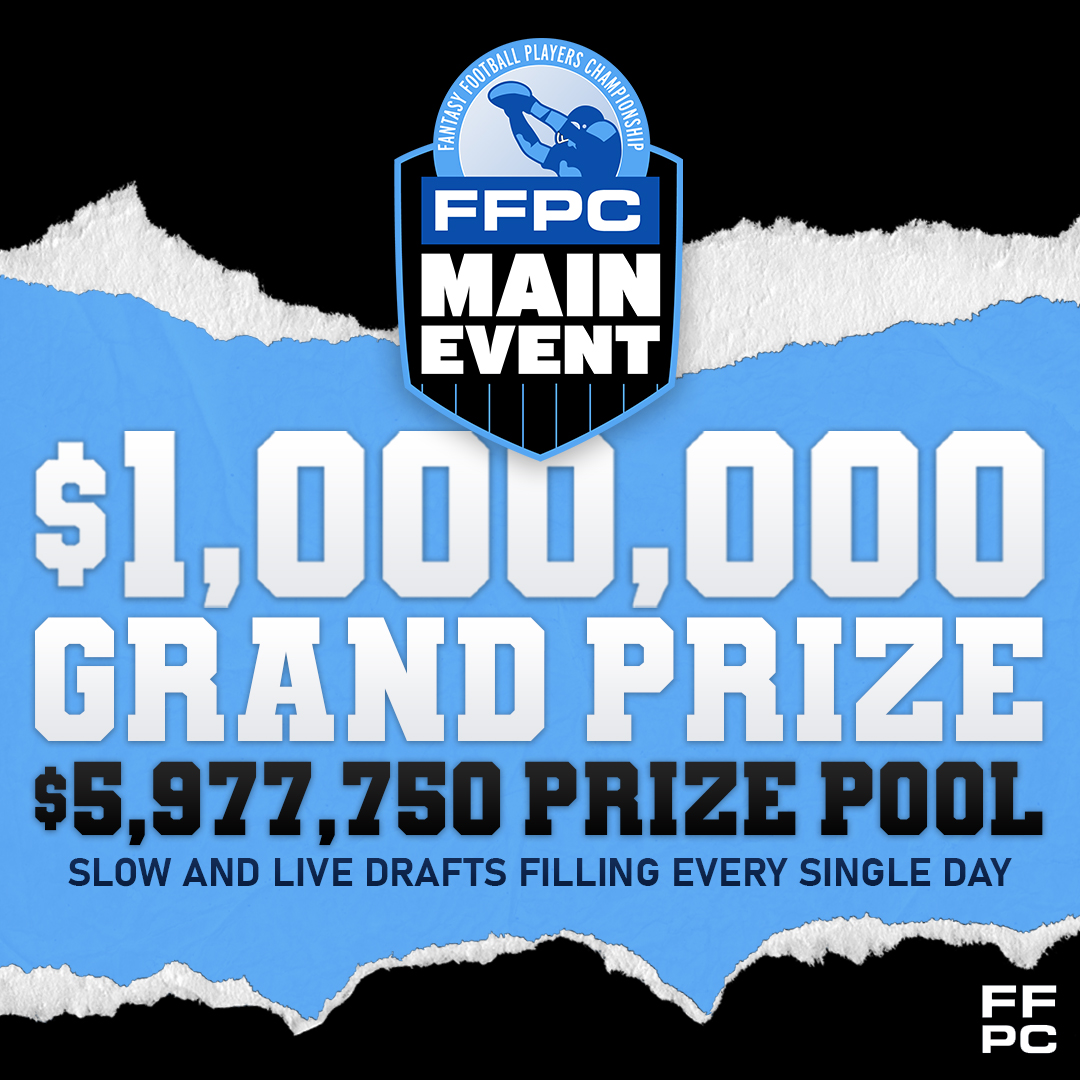Everybody loves a fantasy football sleeper. But fantasy football drafting is a zero-sum game. For every sleeper or undervalued player, there must be an equivalent bust or overvalued player. When crafting a fantasy football draft strategy, it’s important to identify players with red flags. Avoiding these draft land mines, especially in the early rounds, is crucial to keeping your team in contention for the fantasy football championship. Without further ado, here are the most overvalued players at each position:
All ADP values courtesy of FantasyPros’ Half-PPR ADP.
PlayerProfiler is home to the award winning redraft rankings and tools. Our Player Rankings are second to none, and the World Famous Draft Kit contains detailed player write ups and cheat sheets to help You dominate fantasy drafts! Check it out.
Overvalued Fantasy Football Quarterbacks
C.J. Stroud, Houston Texans (ADP: QB5)
My reasoning for this pick is fairly simple. C.J. Stroud is one of the best young quarterbacks in the league, and his rookie campaign was incredible. However, it wasn’t all that great for fantasy. Stroud finished his debut season as just the QB11 in total points and the QB10 with 18.7 points per game. He does have room for growth, especially with the Texans’ addition of another potent receiving threat in Stefon Diggs. His 4.6 percent touchdown rate, in particular, is likely to improve.
The problem is that Stroud brings negligible rushing upside. He averaged just 11.1 yards per game on the ground as a rookie. Without rushing upside, it’s nearly impossible to compete with the top fantasy options at the quarterback position. That’s what he will have to do to live up to his ADP. Stroud is currently being selected just a few picks behind Lamar Jackson and multiple rounds ahead of his fellow elite pocket passers like Joe Burrow and Dak Prescott. As great as he is, Stroud’s ADP is much closer to his ceiling than his floor. Savvy fantasy managers will comfortably pass on him in the fourth round.
Jordan Love, Green Bay Packers (ADP: QB10)
Love isn’t overvalued by as wide a margin as Stroud, but he is still being drafted higher than he should be. While Love did finish as a top-five fantasy quarterback in 2023, he is due for regression in 2024. Specifically, Love accounted for 86-percent of the Packers’ total touchdowns, with 32 passing TDs and four rushing TDs. That number was 4-percent more than any other quarterback not named Josh Allen and 6-percent more than the closest non-running QB (Baker Mayfield).
On the other hand, Love reached another level of play down the stretch of last season, so using season-long numbers may not be giving him his fair due. If he maintains that level of play, he could outperform his QB10 ADP. In fact, I don’t have huge problem with Love’s QB10 ADP. The bigger problem is that Love is out of place in terms of overall ADP. He is currently being drafted No. 75 overall, right behind Dak Prescott (who was better in 2023 and has a longer track record of success) and Kyler Murray (who brings much more rushing upside).
Love would be more at home closer to Brock Purdy, Jared Goff, and Tua Tagovailoa, even if he is still the QB10. These other hyper-efficient pocket passers all have ADPs just past 100, nearly three full rounds later than Love. At his current price, Love is in a no man’s land between the truly elite fantasy quarterbacks and the late-round pocket-passing QBs with upside. He’s not a terrible pick. However, he is undeniably overvalued given the quarterbacks with similar profiles who can be had much later in the draft.
Overvalued Fantasy Football Running Backs
Jahmyr Gibbs, Detroit Lions (ADP: RB6)
I hate to kick Gibbs while he is down following the recent news of his hamstring issue, but the sophomore star was overvalued even before his injury. While Gibbs is a truly electric talent, drafting him as a top-six running back and first-round fantasy pick requires quite a bit of projection. Specifically, fantasy managers drafting Gibbs that early are assuming his role will change dramatically from his rookie-year usage.

Jahmyr Gibbs 2023 Opportunity Metrics
In the 10 regular season games Gibbs played as a rookie in which fellow Detroit RB David Montgomery was healthy, he averaged just 13.9 half-PPR points per game. This would have landed him as the RB11 on the season. Over the last 12 games of last season, this time including the playoffs, Gibbs averaged just 11.2 rush attempts per game on a 53 percent snap share. Given that Montgomery was actually the better running back in terms of PFF Rushing Grade and success rate, I don’t see the Lions rushing to change how they split their backfield. If they don’t, Gibbs will be hard-pressed to live up to his ADP, regardless of whether he is healthy in time for Week 1.
Trey Benson, Arizona Cardinals (ADP: RB36)
Benson, the Cardinals’ third-round pick out of Florida State, has a few things going for him as a fantasy asset. He has a great combination of size and speed, with a 97th percentile 40-yard dash time at 216 pounds. He is behind a 29-year-old running back with a lengthy injury history in James Conner. However, this is not enough to justify his current ADP.
If the rookie were being drafted as a pure handcuff, that would be one thing. But Benson’s RB36 ADP lands him in the ninth round. This is ahead of players like Chase Brown, Gus Edwards, and Jerome Ford, who should see real volume in their backfields regardless of injury. Managers drafting Benson in that spot are assuming he significantly cuts into Conner’s workload. I don’t find that likely. Conner isn’t much of a receiver. However, he consistently ranks among the league’s elite backs in rushing efficiency metrics.
In 2023, the former Steeler was No. 4 in rush yards over expected per attempt and No. 6 in success rate (per NextGenStats). Benson, who underwhelmed in his preseason debut, is not going to steal much rushing work from Conner. Add in that the Cardinals reportedly love Emari Demercado as a third-down back, and it’s hard to see Benson carving out a role large enough to return value at his current ADP.
Overvalued Fantasy Football Wide Receivers
Garrett Wilson, New York Jets (ADP: WR7)
As with Gibbs, it feels bad to pick against Wilson, another extremely talented young player. Wilson ranked No. 19 among WRs with a 26-percent target per route run rate in 2023. Many expert analysts consider him a top 10 wide receiver in the league. But fantasy is a game about numbers. The numbers tell a much less pretty story about Wilson. He ranked just No. 52 among qualified WRs in yards per route run in 2023 and No. 41 in PFF’s Receiving Grade. In terms of fantasy points, his 9.7 points per game landed him No. 39 at the position.
To be fair to the 2022 10th overall pick, it’s hard to put up big numbers while catching passes from Zach Wilson and Trevor Siemian. The return of future Hall of Famer Aaron Rodgers is all but guaranteed to increase Wilson’s production in 2024. On the other hand, this isn’t prime Aaron Rodgers. In Rodgers’ last season in Green Bay, he posted just 6.8 adjusted yards per attempt. This was a far cry from his 8.3 career average or 10.5 peak. Also, that was before he tore his Achilles at the age of 39.
I would be happy to bet on a breakout season from Wilson if his ADP was lower. But Wilson is currently being drafted in the early second or even late first round. That price implies that a breakout already happened, not just that it might happen. If Rodgers gets hurt again, or Wilson simply isn’t as elite a talent as the consensus thinks, he could end up as one of the biggest busts of the season, just like he was last year.
Jayden Reed, Green Bay Packers (ADP: WR35)
Honestly, my entire case against Reed comes down to one number: three. That’s how many routes Reed ran in two-WR sets as a rookie. Even though he posted very impressive numbers on a per-route basis in 2023, that number is a massive red flag for his fantasy outlook, both ceiling and floor. Playing only in three-receiver formations places a hard cap on Reed’s snap share and route participation. Even if we look only at passing plays, the Packers’ offense used two or fewer receivers 26-percent of the time in 2023. That’s 26-percent of potential routes that Reed is guaranteed to miss out on, before we even consider the fact that the Packers have four talented young receivers (Reed, Christian Watson, Romeo Doubs, and Dontayvion Wicks) competing for snaps in three-WR sets.
Of course, this was true last year, and Reed still finished as the WR23 in both total points and points per game. But that finish relied on him greatly outperforming his expected stats, thanks largely to touchdown production, which is notoriously unreliable from year to year. Reed is by no means a lock to underperform his ADP, but I can’t recommend targeting a receiver in a part-time role in the seventh round of fantasy drafts.
Overvalued Fantasy Football Tight Ends
Sam LaPorta, Detroit Lions (ADP: TE1)
Coming off a dominant TE1 overall finish as a rookie, it makes plenty of sense that LaPorta is the first tight end off draft boards heading into 2024. But looking under the hood, the Iowa product was a bit fortunate to finish as the TE1. For one, his points per game average was much lower than usual from the overall TE1, and Mark Andrews outscored him on a per-healthy-game basis. For another, a disproportionate amount of LaPorta’s production came from his position-leading 10 touchdowns.
Touchdowns accounted for over 30-percent of LaPorta’s half-PPR scoring. This was by far the most of any top 12 TE (Cole Kmet was second at 24.9-percent). And LaPorta was outside the top three tight ends in each of targets, receptions, and yards. If we ignore touchdowns for a second, he ranks as just the TE4 from 2023. And, as I just mentioned with Reed, touchdown rate on a year-to-year basis is very unpredictable. Just regression on the TD front could bring LaPorta from the clear TE1 to fighting to remain in the top three at the position.

Sam LaPorta Opportunity & Productivity Metrics
There are also other reasons to question if LaPorta can repeat as the top tight end in fantasy football. Especially compared to the dominant seasons we’ve seen from guys like Andrews, Travis Kelce, and Rob Gronkowski, his 2023 peripheral numbers were nothing special. Among 18 tight ends with at least 70 targets, LaPorta had the No. 4-highest pass-block rate and No. 6-highest percentage of routes coming from in-line.
Those are both indicators of not particularly fantasy-friendly usage. He also ranked fourth-to-last in that group in yards after the catch per reception, meaning he wasn’t generating many explosive plays. Putting it all together, LaPorta’s early third-round ADP is too rich for my blood.
Dalton Kincaid, Buffalo Bills (ADP: TE5)
In many ways, Kincaid is the Jahmyr Gibbs of tight ends. Another member of the 2023 NFL draft class, Kincaid has a tantalizing fantasy ceiling if he reaches his full potential. A receiving-first TE, Kincaid doesn’t have any of the same role problems as LaPorta. He was only asked to pass block six times all season and ran over 80 percent of his routes from out wide or in the slot. But there’s a reason he keeps showing up in these articles. Just like Gibbs, Kincaid has a usage problem caused by a veteran teammate. In 13 games (playoffs included) where Dawson Knox was healthy, Kincaid averaged just a 58 percent snap share and a 69 percent route participation rate … and 6.3 half-PPR points.
To be fair, Kincaid’s role is almost certain to expand in his sophomore season. Tight ends often take a year or two to acclimate to the NFL, and the departures of Gabe Davis and Stefon Diggs leave the Bills looking for playmakers in the receiving game. But projecting Kincaid to return value at his current ADP requires assuming that a leap will happen and then some. At the very least, Kincaid should be going after George Kittle, a proven veteran. Additionally, he should be drafted after Kyle Pitts, another young potential unicorn with a more guaranteed role.
For more articles from Ted Chmyz, click here – Fantasy Football Stacks with League Winning Potential – Top 10 (playerprofiler.com)










